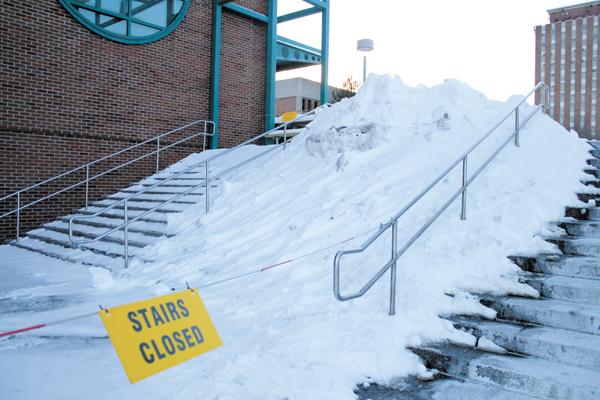
The buildup of ice and snow during the winter months is a near daily challenge for the members of the grounds crew at Binghamton University, and it can sometimes take the efforts of hundreds of workers to brush off the cold.
In the event of snowstorms, the BU grounds crew is the primary group working to remove the snow and make BU’s 6.3 miles of roads, 23 miles of walkways, 35 acres of parking lots, as well as other surfaces, clear for use by students, staff and faculty.
“Our staff does the most of the snow removal work,” said Karen Fennie, the communications director for physical facilities, which manages buildings and grounds. “We do have a service contract that we can use when there are large snowfall events. We use this contract to get rid of the big piles of snow that obstruct visibility, especially in parking lots.”
Such large snowfall events can involve the use of up to 230 people working on snow removal, according to information from physical facilities.
A combination of vehicles and manpower are used for snow removal. The physical facilities fleet consists of many vehicles, including brush trucks, snow plows of various sizes, dump trucks and pickup trucks. The brush trucks, also known as “skidsters,” use large spinning brushes that sweep snow off paths, and are among the most recent additions to the fleet. They can often be seen clearing the walkways around campus.
Workers also attack the snow with shovels and combinations of sand and salt. Because of salt’s impact on the environment, the grounds crew tries to limit its salt use to priority areas and where there is significant ice. The physical facilities website states that workers will try using a water and salt solution to pretreat areas that normally require salting after a storm for the first time this winter.
The grounds crew begins work even if the snowfall is relatively minor. According to University policy, a half-inch of snow accumulation is enough to warrant sending out the cleanup crew, whereas the Town of Vestal begins plowing after three inches of accumulation. In favorable conditions, it can take workers two and a half hours to reach all the walkways on campus and anywhere from two to four hours to do a single pass on parking lots.
The University must deal with various measures when deciding whether to cancel classes due to snow.
According to Binghamton University spokeswoman Gail Glover, the University president has the authority to cancel classes, but state buildings may only be closed under the authority of the Governor.
“The president’s decision is based on input from a variety of sources [with] the biggest consideration being the safety of both our commuting students and our residential community,” Glover said.
Binghamton’s New York State University Police gathers weather-related information for the University from the National Weather Service and local sheriffs, which helps influence the president’s decision.
In the event that classes are cancelled, the administration sends out text message and e-mail alerts to notify students, and updates the BU Alert line, a telephone number that can be dialed from on or off campus, as well as the University’s main website with cancellation messages. Students can learn more about finding out whether classes are canceled at emergency.binghamton.edu/?page=Notification/Method.
Off Campus College Transport bus service has also occasionally been cancelled due to snowstorms in the past. OCCT Director Giovanni Torres said that he and his team start formulating plans when heavy snowfall is in the forecast.
“The decision to cancel buses is made by a group — myself and my sub-managers,” Torres said. “If we see the night before that a bad blizzard is predicted, we will call each other up to discuss plans and try to figure out how bad conditions are going to be. We’ll also contact people within the University like UPD to see what their operations forecast is.”
According to Torres, the biggest factor affecting bus service is the timing of the storm.
“It depends on when the snowstorm arrives and how well the roads are plowed,” Torres said. “If the streets are clear in the morning and the snow only starts in the middle of the day when we’re already up and running, we may not have to cancel service. But if the snow happens overnight and the roads are blocked the next morning that’s a different story.”


